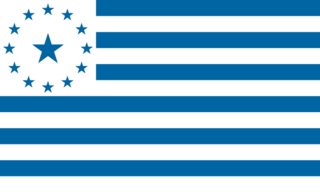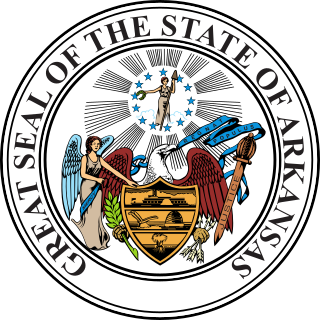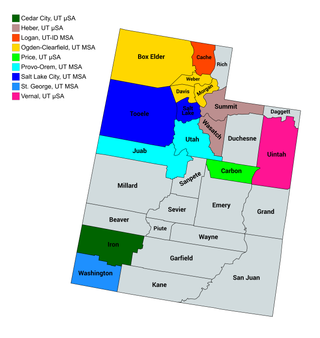
The Territory of New Mexico was an organized incorporated territory of the United States from September 9, 1850, until January 6, 1912. It was created from the U.S. provisional government of New Mexico, as a result of Nuevo México becoming part of the American frontier after the Treaty of Guadalupe Hidalgo. It existed with varying boundaries until the territory was admitted to the Union as the U.S. state of New Mexico. This jurisdiction was an organized, incorporated territory of the US for nearly 62 years, the longest period of any territory in the contiguous United States.

The State of Deseret was a proposed state of the United States, promoted by leaders of the Church of Jesus Christ of Latter-day Saints who had founded settlements in what is today the state of Utah. A provisional state government operated for nearly two years in 1849-50, but was never recognized by the United States government. The name Deseret derives from the word for "honeybee" in the Book of Mormon.

The Territory of Idaho was an organized incorporated territory of the United States that existed from March 3, 1863, until July 3, 1890, when the final extent of the territory was admitted to the Union as Idaho.

The Arkansas Territory was a territory of the United States that existed from July 4, 1819, to June 15, 1836, when the final extent of Arkansas Territory was admitted to the Union as the State of Arkansas. Arkansas Post was the first territorial capital (1819–1821) and Little Rock was the second (1821–1836).

The Utah Supreme Court is the supreme court of the state of Utah, United States. It has final authority of interpretation of the Utah Constitution. The Utah Supreme Court is composed of five members: a chief justice, an associate chief justice, and three justices. All justices are appointed by the governor of Utah, with confirmation by the Utah Senate. The five justices elect one of their own to serve as chief justice and another to serve as associate chief justice, each for a term of four years.

The Utah State Legislature is the state legislature of the U.S. state of Utah. It is a bicameral body, comprising the Utah House of Representatives, with 75 state representatives, and the Utah Senate, with 29 state senators. There are no term limits for either chamber.

John Milton Bernhisel was an American physician, politician, and early member of the Latter Day Saint movement. He was a close friend and companion to both Joseph Smith and Brigham Young. Bernhisel was the original delegate of the Utah Territory in the United States House of Representatives and acted as a member of the Council of Fifty of the Church of Jesus Christ of Latter-day Saints.

The U.S. State of Utah currently has eleven statistical areas that have been delineated by the Office of Management and Budget (OMB). On July, 2023, the OMB delineated one combined statistical area, five metropolitan statistical areas, and six micropolitan statistical areas in Utah.

John Thomas Caine was a delegate to the United States House of Representatives from the Territory of Utah.

The Puerto Rico statehood movement aims to make Puerto Rico a state of the United States. Puerto Rico is an unincorporated territorial possession of the United States acquired in 1898 following the Spanish–American War, making it "the oldest colony in the modern world". As of 2019, the population of Puerto Rico is 3.2 million, around half the average state population and higher than that of 20 U.S. states. Statehood is one of several competing options for the future political status of Puerto Rico, including: maintaining its current status, becoming fully independent, or becoming a freely associated state. Puerto Rico has held six referendums on the topic. These are non-binding, as the power to grant statehood lies with the US Congress. The most recent referendum was in November 2020, with a majority (52.52%) of those who voted opting for statehood.
This timeline is a chronology of significant events in the history of the U.S. State of Colorado and the historical area now occupied by the state.
Admission to the Union is provided by the Admissions Clause of the United States Constitution in Article IV, Section 3, Clause 1, which authorizes the United States Congress to admit new states into the Union beyond the thirteen states that already existed when the Constitution came into effect. The Constitution went into effect on June 21, 1788, in the nine states that had ratified it, and the U.S. federal government began operations under it on March 4, 1789, when it was in effect in 11 out of the 13 states. Since then, 37 states have been admitted into the Union. Each new state has been admitted on an equal footing with those already in existence.
This timeline is a chronology of significant events in the history of the U.S. State of New Mexico and the historical area that is now occupied by the state.
This timeline is a chronology of significant events in the history of the U.S. State of Wyoming and the historical area now occupied by the state.
This timeline is a chronology of significant events in the history of the U.S. State of Montana and the historical area now occupied by the state.
This timeline is a chronology of significant events in the history of the U.S. State of Arizona and the historical area now occupied by the state.
This timeline is a chronology of significant events in the history of the U.S. State of Idaho and the historical area now occupied by the state.
References are included in the linked articles.









